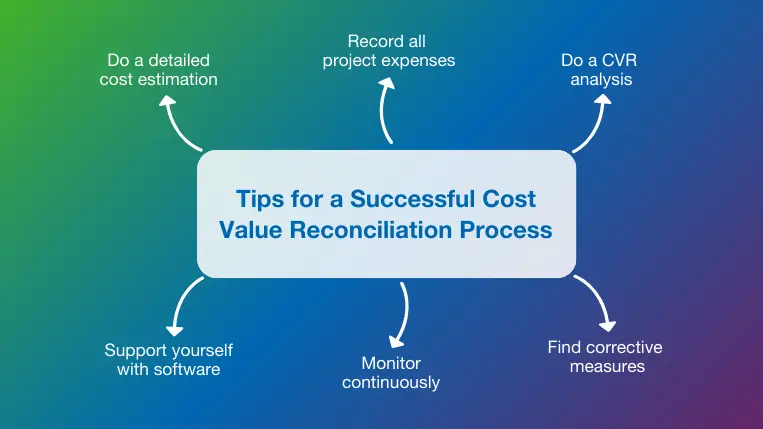11 mins read
What is Cost Value Reconciliation? Reviewing the Principles and Best Practices Behind It

Cash flow issues in the construction industry are much too important to ignore. That is the basic premise behind cost value reconciliation (CVR). This well-defined process provides deeper insight into project performance while preventing cost overruns, improving transparency, and supporting informed decision-making. CVR is one of many established practices that leverages intelligent construction management software to improve accuracy, efficiency, and collaboration in construction projects.
What Is Cost Value Reconciliation in Construction?
Cost value reconciliation (CVR) is a process used in the construction industry to compare initial estimates of project costs to actual expenses incurred. These variances give stakeholders insight into a project’s financial progress, performance, and risks.
The CVR meaning and importance can be conveyed through the three essential components required to complete cost value reconciliations:
- Value of a project: The value of a construction project is determined by adding up all project incomes. This includes all amounts already received as well as funds expected at the conclusion.
- Costs of a project: The costs of a construction project are calculated based on all expenses incurred during the project’s lifecycle. The CVR uses this information to compare costs incurred to work completed.
- Cash flow: The third essential component is cash flow, which is the difference between money coming in and money going out, or the current value minus the current costs of the project. Cash flow provides an important barometer of project health and schedule risk.
The cost value reconciliation process involves assessing these three key elements at set intervals and reporting on the current project status and the expected (predicted) profitability. CVR reports allow clients, project managers, and other stakeholders to make timely course corrections that keep projects in the black.
Who Is Responsible for CVR?
Depending on the project structure and company preferences, company leaders, construction project managers, general contractors, and other stakeholders can be responsible for CVR reporting. No matter who compiles and distributes the CVR reports, everyone with a vested interest in expense management, budgeting, and profitability should understand how to interpret the results.
Each cost value reconciliation report should provide a self-explanatory summary of the construction project’s financial standing. The introduction and summary sections help to set the stage and give some context for the report, along with a brief project summary and timeline. The report should highlight any identified risks or other areas requiring immediate attention.
When Does CVR Take Place?
Ideally, cost reconciliation should occur as often as possible to identify problems and trends early. Since this is not always feasible, common industry practice is to complete CVR reporting once a month during the project and an additional report near the end of the project.
Construction analytics software makes it easier for teams to perform cost value reconciliation and reporting more frequently, so a lack of time or resources doesn’t become a reason to ignore financial risks.
What Metrics are Included in CVRs?
The CVR report aims to provide a meaningful snapshot of financial performance and put variances and other trends into perspective. Metrics and key performance indicators (KPIs) create a standardized approach to construction reporting that highlights essential figures, including the current value, cost, and cash flow for the project, as well as:
- Earned value analysis (EVA): The planned percentage completion of each project activity multiplied by its budgeted value can help assess progress and financial health.
- Cost variance analysis (CVA): This metric compares actual costs to originally budgeted costs to help pinpoint where any variances are coming from.
- Schedule performance index (SPI): Dividing the earned value by the actual costs reveals adherence to the budget and timeline. An SPI above 1.0 shows that the project is ahead of schedule, and anything below 1.0 indicates potential problems to be addressed.
Cost Value Reconciliation Benefits
The insights provided by CVR improve project performance and financial decision-making while controlling risks, bringing more stability to the project. Cost value reconciliation can also become a platform for continuous improvement as project teams learn from mistakes to improve construction cost estimation practices and eliminate variances in the future. CVR also brings additional benefits that contribute to a positive cash flow.
- Cost control: CVR helps construction teams monitor and manage expenses in real-time, ensuring that spending aligns with the budget and preventing cost overruns. This is essential for maintaining efficient cost control in construction projects.
- Performance assessments: Cost value reconciliations can also be used to assess the performance of suppliers and contractors. Comparing bids and estimates to actual costs helps to gauge a partner’s reliability and ability to stick to agreements.
- Transparency: CVR provides detailed financial data that enhances transparency among stakeholders regarding costs and progress. This visibility improves communication and decision-making while building trust with clients.
Tips for a Successful Cost Value Reconciliation Process

The CVR is straightforward, but optimizing its usefulness requires accurate and timely data. A few essential tips and best practices ensure that errors or inaccuracies do not overshadow the benefits of cost value reconciliation.
Do a Detailed Cost Estimation
The cost of a project can be challenging to determine with a high level of accuracy, so a deep dive into cost data may be necessary. Elemental cost analysis (ECA) is a valuable practice that breaks construction costs into fundamental elements such as materials, labor, equipment, and overhead. This granular data is an ideal resource for cost value reconciliation since it makes accurate comparisons between estimated and actual costs possible to easily identify overruns.
Record All Project Expenses
Once the project begins, tracking all ongoing expenses can become daunting since data from various sources needs to be gathered, sorted, and tracked. Inadequate expense tracking is one reason construction firms report higher costs than anticipated. Along with meticulous expense tracking to support CVR, carefully selected KPI targets help monitor project performance, identify cost inefficiencies early, and provide clear insights that can lead to quick course corrections.
Do a CVR Analysis
Accurate and timely cost estimations and expense tracking are required to complete the CVR analysis. The analysis step involves comparing actual costs with projected costs, analyzing variances to determine their cause, and assessing the project’s financial performance. CVR metrics should highlight areas where costs have exceeded expectations. The causes for these discrepancies might include material price fluctuations, labor inefficiencies, or unforeseen project challenges, all of which introduce project risks and require corrective action.
Find Corrective Measures
When the CVR analysis and metrics indicate issues (such as an SPI less than 1.0), steps must be taken to avoid future cost overruns and discrepancies. These corrective measures can include negotiating better terms with suppliers, reallocating resources to improve efficiency, adjusting project timelines, or implementing tighter cost controls with more frequent or stringent expense reporting.
Monitor Continuously
While reporting CVR to stakeholders monthly may be the norm, that does not prevent you from continuously monitoring cost value reconciliation inputs and metrics. Cloud-based construction software makes minimizing the lag between data collection and analysis easier. Continuous monitoring allows construction teams to identify emerging issues and make real-time adjustments quickly. The mindset of continuous improvement is one of the key principles of lean construction that many organizations implement for success.
Support Yourself with the Right Technology
The volume of data collection, reporting, and analysis required to complete effective cost value reconciliation can make it difficult to maintain both timeliness and accuracy. As projects expand in size and scope, advanced software tools and technology become essential. These tools include construction management, real-time data tracking systems, integrated accounting software, and interactive dashboards.
Technology minimizes project risks and errors by eliminating manual calculations and data entry while improving efficiency through automated workflows. Construction management and cost management software solutions allow businesses to scale their operations by providing the real-time data collection and analysis capabilities needed to manage millions of cost elements. These tools also improve communication across stakeholders and enable more informed and proactive decision-making.
RIB Candy is a versatile estimating, planning, and project control solution perfectly suited to the complexity and scope of construction CVR. The software offers a wide range of customized reports to compare initial estimates to as-built totals and find improvement opportunities to keep the financial aspects of the project on track. It also allows users to integrate quantity takeoffs, estimations, and schedules to ensure decisions are made with the full picture in mind.
Final Thoughts
Construction projects encompass a variety of expense categories that are subject to both planned and unplanned changes. At the same time, monitoring, analyzing, and controlling costs effectively is no longer optional when it comes to meeting aggressive budgets and ensuring profitability.
RIB Candy, our construction estimating software, makes it easier to maintain financial visibility while freeing valuable resources from time-consuming metric calculations and report generation. Get your free demo today and discover how our professional software can aid in cost efficiency and control, schedule adherence, and overall project success!

Most Recent
11 mins read
10 mins read
10 mins read
29 mins read
Blog Categories

Ebook











